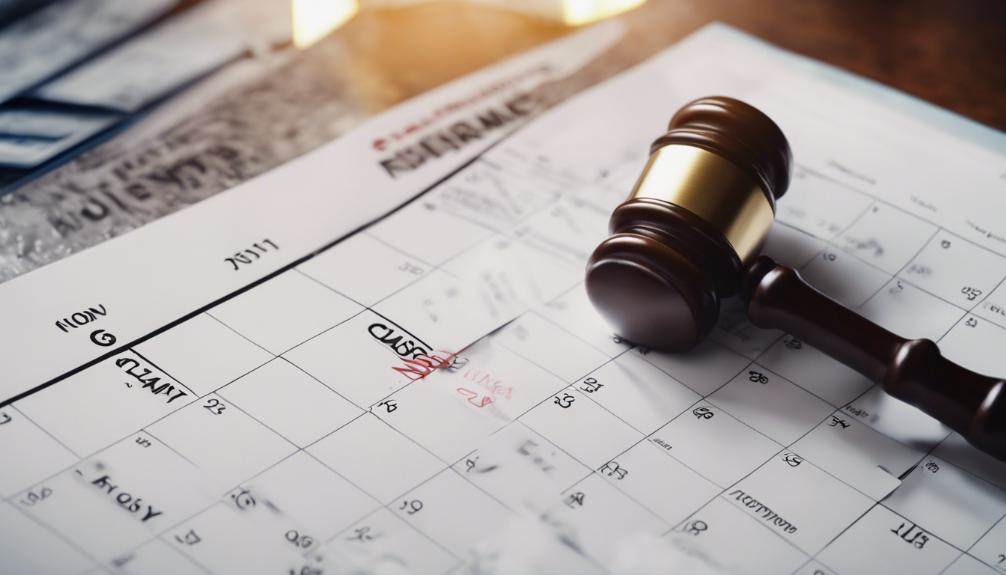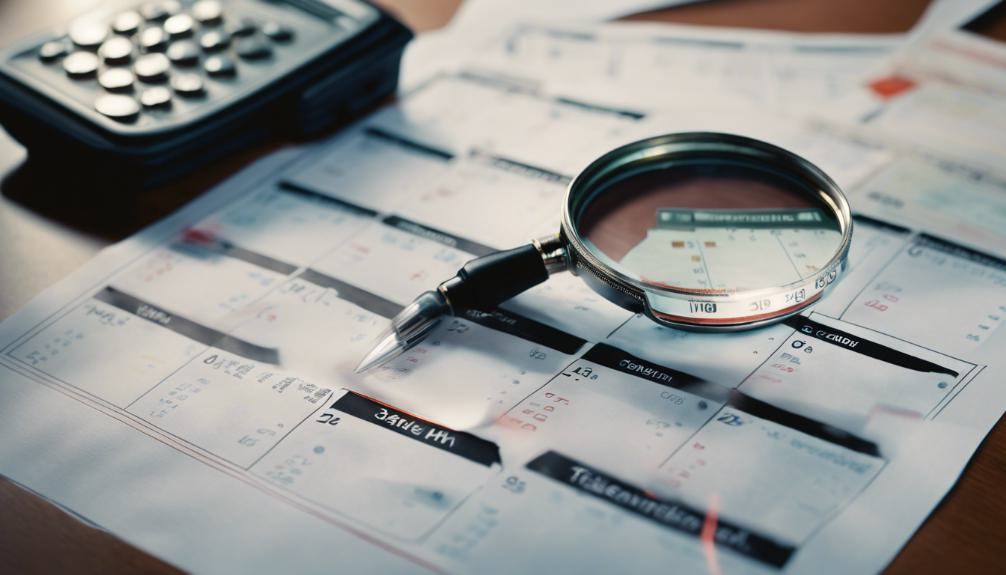Maximize Your Claim: Know Your Timeline
In the domain of insurance claims and legal actions following an accident, the significance of understanding and adhering to specific timelines cannot be overstated. Each step, from filing an insurance claim to pursuing a lawsuit, is bound by deadlines and statutes of limitations that vary by jurisdiction. This precise knowledge not only guarantees the validity of your claim but may considerably influence the outcome. However, the intricacies of these timelines and the strategic decisions they necessitate often remain obscured to those unfamiliar with the legal landscape. As we explore these critical aspects, one must consider how an adept navigation through this complex terrain can potentially maximize claim benefits and impact the pursuit of justice.

Key Takeaways
- Understand statutes of limitations to file claims or lawsuits within legal deadlines.
- Immediate action and evidence collection post-incident strengthen your claim's validity.
- Interact clearly with adjusters and consider legal support for negotiation leverage.
- Thoroughly assess settlement offers against damages before acceptance to ensure full compensation.
Filing Insurance Vs. Lawsuits

Understanding the differences between filing an insurance claim and pursuing a lawsuit is important for maximizing your claim's potential benefits and timeline. When you file an insurance claim, you're seeking compensation within the framework of your policy agreement with the insurer. This process typically involves notifying your insurance company about the incident, providing necessary documentation, and working with an adjuster to evaluate the claim. It's generally quicker and involves less legal complexity than a lawsuit. On the other hand, filing a lawsuit involves taking legal action against the party responsible for your damages, which can be a lengthy and intricate process requiring legal representation. It's usually pursued when insurance coverage is insufficient or when negotiations with insurance companies fail.
Accident Claim Deadlines

Exploring through the intricacies of accident claim deadlines is essential for ensuring timely submission and maximizing potential compensation. The timeline for filing an accident claim with insurance varies greatly across jurisdictions and depends on the specifics of the insurance policy. Initiating the claim process as soon as possible is critical, as delays can hinder the ability to recover costs associated with the accident. The process typically involves contacting the insurer, providing detailed evidence of the accident, and interacting with insurance adjusters. Understanding the correct entity with whom to file your claim, whether it's your insurance company or the at-fault party's insurer, is fundamental. Immediate action not only facilitates smoother proceedings but also strengthens your position in negotiation phases, ultimately leading to a more favorable settlement offer.
Understanding Statutes of Limitations

Understanding the complexities of statutes of limitations is essential for ensuring that legal claims and lawsuits are filed within permissible time frames. These laws set the maximum period one can wait before filing a lawsuit, varying greatly by jurisdiction and the nature of the claim. For instance, personal injury claims might have a different statute of limitations compared to property damage or contract disputes. Ignorance of these deadlines can lead to the forfeiture of the right to sue for damages. Hence, it's vital for individuals to familiarize themselves with the specific statutes of limitations applicable to their case, which often start from the date of the incident or discovery of harm. Prompt consultation with legal professionals can help navigate these legal nuances effectively, ensuring timely and appropriate filing of claims.
Immediate Claim Benefits

Initiating an insurance claim promptly after an accident can yield significant advantages, including faster access to compensation and support for recovery efforts. Understanding the filing process and being aware of deadlines is vital. Filing an insurance claim differs from filing a lawsuit, both with regards to process and time sensitivity. Beginning the claim process as soon as possible guarantees that evidence is fresh and more easily accessible, which can be pivotal in establishing the facts of the case. Additionally, adhering to the statute of limitations, which varies by state and type of claim, is essential to preserve one's right to compensation. Quick action also facilitates a smoother interaction with insurance adjusters, potentially leading to an expedited settlement offer, thereby accelerating the path to financial and physical recovery.
Identifying the Right Party

After addressing the importance of timely claim initiation, it becomes imperative to focus on identifying the appropriate party with whom to file your insurance claim. This step is critical as it directly influences the success of your claim process. Depending on the nature of your case, this could be your own insurance company or the insurer of another party involved in the incident. It is important to understand your policy's coverage and any potential liabilities or exclusions.
Research and due diligence play important roles here. Reviewing accident reports, consulting with legal advisors, and thoroughly understanding state laws and procedures regarding insurance claims can guide you in making the correct identification. This ensures that your claim is filed correctly, thereby avoiding unnecessary delays or rejections.
Navigating At-Fault States

Handling at-fault states requires a thorough grasp of how liability and insurance claims are determined and processed within these jurisdictions. In at-fault states, the driver who caused the accident bears financial responsibility for the damages incurred. This determination of fault is critical, as it directly influences the filing process and potential recovery. Victims must file a claim with the at-fault driver's insurance company, maneuvering state-specific statutes of limitations and procedural requirements. Understanding the timeline for filing an insurance claim versus a lawsuit is paramount. Early initiation of the claim process is recommended to guarantee evidence preservation and adherence to deadlines. Additionally, engaging with insurance adjusters and providing detailed evidence of the accident and resultant damages is essential for a favorable outcome.
No-Fault State Procedures

Understanding the procedures within no-fault states is equally important for efficiently traveling the insurance claim process in these jurisdictions. In no-fault states, policyholders file a claim with their own insurance company regardless of who is at fault for the accident. This system aims to expedite compensation for injuries by minimizing the need to prove fault, thereby reducing legal and administrative costs. It's important to familiarize oneself with the specific requirements and deadlines unique to each no-fault state, as these can have a substantial impact on the claim process. For instance, some states require medical treatment to be obtained within a certain timeframe following an accident to be eligible for personal injury protection (PIP) benefits. Understanding these nuances is key to traveling the no-fault system effectively.
Step-by-Step Claim Filing

Initiating an insurance claim involves a series of critical steps designed to make sure that policyholders navigate the process efficiently and secure the compensation they are entitled to. First, promptly report the incident to your insurance provider. This initial contact is vital for setting the claim in motion and adhering to any specific deadlines your policy might impose. Following this, gather and submit all necessary documentation, such as accident reports, medical records, and evidence of damages. This step is essential for substantiating your claim. Next, communicate with the assigned insurance adjuster to discuss the specifics of your case. It is important to provide accurate information and cooperate fully during this evaluation phase. Finally, review the settlement offer carefully before accepting to ensure it adequately covers your losses.
Researching Claim Time Limits

Investigating the specific time limits for filing an insurance claim is an essential first step in ensuring timely compensation for your losses. Different types of insurance policies and claims, such as those for property damage, personal injury, and automobile accidents, may have varied deadlines. These deadlines can be influenced by state laws and the specific terms of your insurance policy. Understanding the statute of limitations, which is the legal deadline for filing a lawsuit, is also vital, as it can affect your ability to seek further compensation if your claim is denied. Starting the claim process as soon as possible is advised to avoid missing critical deadlines. Familiarize yourself with the filing procedures and timelines specific to your claim to navigate the process efficiently.
Evidence and Insurer Communication

Gathering thorough evidence and establishing clear communication with your insurer are pivotal steps in the claim filing process. When an accident occurs, it is important to collect as much evidence as possible. This includes photos of the scene, witness statements, and any relevant documents. This evidence not only supports your claim but also helps in accurately determining the compensation amount.
Simultaneously, initiating and maintaining clear, consistent communication with your insurance company is important. It helps that all necessary information is shared, and any queries from either party can be addressed promptly. Proper communication aids in setting realistic expectations and facilitates a smoother claim process. Remember, the goal is to provide the insurer with enough evidence to assess your claim fully without unnecessary delays.
Dealing With Adjusters

Interacting with insurance adjusters is an important step in the claim process, requiring clear communication and strategic negotiation to guarantee fair compensation. After filing your claim, an adjuster is assigned to evaluate the case. It's essential to be prepared: have all documentation, such as reports and receipts, readily available. Communicate effectively, but be wary of sharing too much information that could inadvertently affect your claim negatively. Adjusters are skilled negotiators working in the insurer's interest, so understanding your policy's details is key. While maintaining professionalism, assert your rights and the value of your claim. Remember, adjusters handle numerous cases, so clear, concise, and factual interactions can help expedite your claim's resolution.
Settlement Offer Dynamics

After effectively managing communication with insurance adjusters, the next important step in the claim process involves understanding the dynamics of settlement offers. Settlement offers are the insurance company's proposal to resolve your claim. It is necessary to recognize that the initial offer is often not the final one; it serves as a starting point for negotiations. Understanding the factors that influence the size of the offer is key. These include the extent of your damages, documentation provided, and the policy limits. It is also crucial to be aware of the insurer's tactics, such as making low initial offers expecting negotiations. Knowledge of these dynamics empowers claimants to engage in more effective negotiations, aiming for a settlement that accurately reflects their losses and injuries without prematurely accepting an inadequate offer.
Accepting Insurance Offers

Deciding whether to accept an insurance company's offer requires careful consideration of the compensation's adequacy in covering all damages and losses incurred. It's important to thoroughly assess the offer against the actual cost of your damages, including medical expenses, lost wages, and any other related costs. Accepting an offer too hastily without proper evaluation can lead to settling for less than what is needed to fully recover.
When reviewing an insurance offer, it's advisable to compare it against independent estimates of your damages. This comparison can provide a stronger basis for accepting the offer or negotiating for a higher settlement. Remember, once an offer is accepted, it typically releases the insurance company from further claims related to the incident. Hence, ensuring the offer fully compensates for all damages is paramount before acceptance.
Legal Support in Claims

Seeking legal assistance can greatly enhance the strength of your insurance claim, ensuring a thorough evaluation and negotiation of fair compensation. A lawyer specializing in insurance claims brings a wealth of knowledge regarding state laws, procedures, and the intricacies of filing processes. They are adept at dealing with insurance adjusters, understanding the importance of timely filing, and ensuring all necessary documentation and evidence are meticulously compiled. Legal support is important in identifying and advocating for the full extent of compensable damages, providing strategic advice on when to accept an offer or escalate the matter. Additionally, lawyers can navigate the complexities of at-fault and no-fault states, maximizing the potential of your claim through their expertise and negotiation skills.
Lawsuit Considerations for Damages

When considering the pursuit of a lawsuit for additional damages, it is important to understand the legal framework and potential implications of such a decision. Filing a lawsuit can often extend beyond the scope of initial insurance claims, aiming for compensation that covers the full extent of damages incurred. This process necessitates a meticulous assessment of the statute of limitations, as different jurisdictions impose varying deadlines for filing a claim. Additionally, understanding whether you are in an at-fault or no-fault state influences the strategy for pursuing additional damages. Engaging with a legal professional can provide invaluable guidance, ensuring that the lawsuit is filed in a timely manner and that all evidentiary requirements are met. This approach maximizes the potential for a favorable outcome, ensuring that the damages awarded reflect the true extent of the harm suffered.
Frequently Asked Questions
How Does Filing a Claim for an Accident Affect My Insurance Premiums in the Future?**
Filing a claim for an accident can potentially affect future insurance premiums, as insurers may view you as a higher risk. This could lead to increased rates or changes in policy terms upon renewal.
This Question Delves Into the Consequences of Filing a Claim on Future Insurance Costs, a Topic Often Not Covered in Detail in Articles Focused on the Process and Deadlines of Filing.
The question addresses the impact of filing an accident claim on future insurance premiums, a vital aspect often overlooked. It highlights the need for understanding the long-term financial implications of such actions on insurance costs.
Can I File a Claim if I Was Partially at Fault for the Accident?**
Yes, you can file a claim even if you were partially at fault for the accident. However, the compensation received may be reduced based on your degree of fault under comparative negligence laws.
While Articles May Discuss At-Fault Versus No-Fault States, They Might Not Address the Nuances of Shared Fault and How It Impacts the Ability to File a Claim or the Compensation Received.
Shared fault in auto accidents can complicate filing claims and affect compensation, as not all discussions on at-fault versus no-fault states fully explore these intricacies, impacting individuals' understanding and strategies in claim proceedings.
What Should I Do if the Other Party Involved in the Accident Disputes the Claim or Provides False Information?**
If the other party disputes the claim or provides false information, it is important to gather evidence, such as photos, witness statements, and police reports, and consult with a legal professional to safeguard your interests.
Conclusion
To sum up, the process of maximizing claim outcomes following an accident necessitates a thorough understanding of insurance filing procedures, statutes of limitations, and the implications of state laws. Prompt and informed action is essential in maneuvering the complexities of insurance claims and considering litigation for additional damages. By identifying the correct party, understanding settlement dynamics, and potentially engaging legal support, individuals can enhance their prospects for favorable compensation within the established legal framework.

This post has been generated by AI and was not reviewed by editors. This is Not legal advice. Please consult with an attorney.




